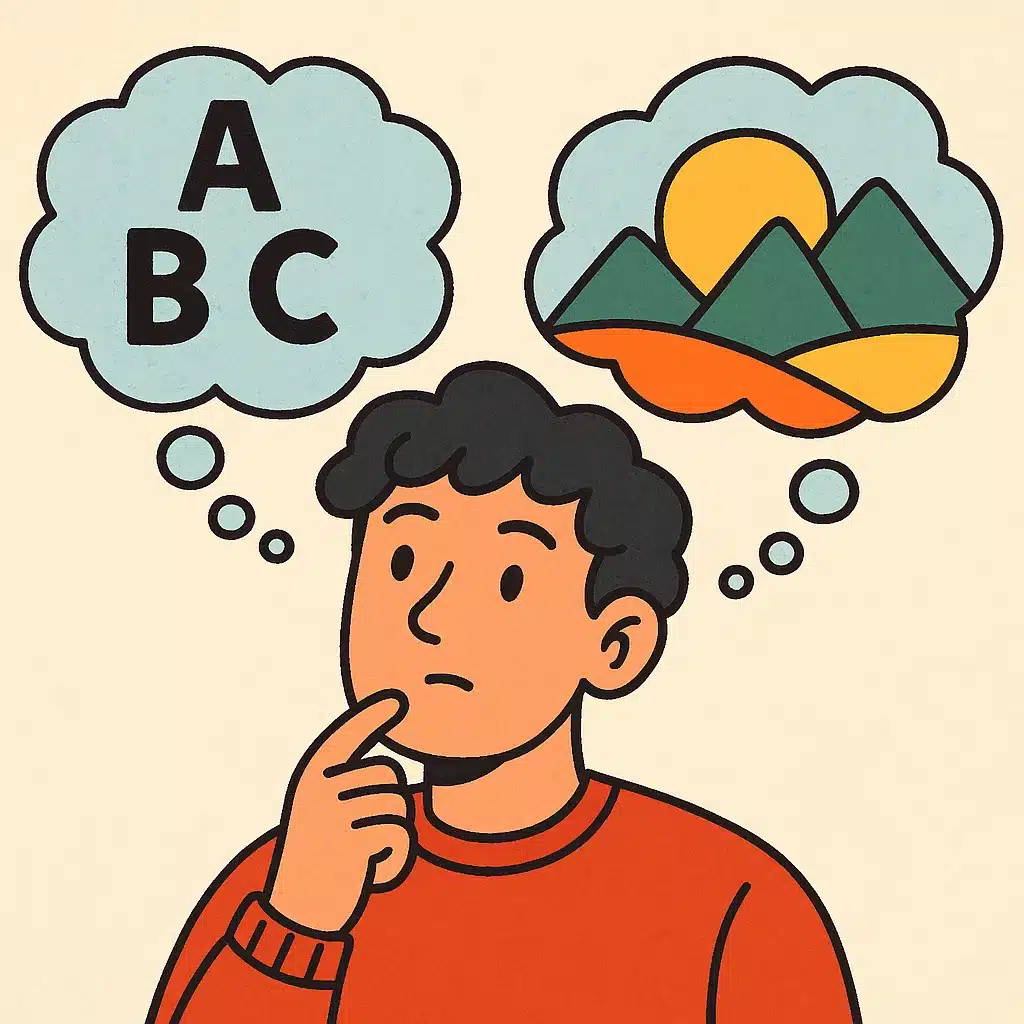Understanding whether you think in words or images first influences creativity, learning, and even how you interact with AI. This article breaks down cutting‑edge research, personality types, and implications for education and design.

Visual vs. Verbal Thinking: Who’s in Charge?
Dual‑Coding Theory suggests our brain processes information via two separate channels—verbal and imagery—and that combining both boosts memory and comprehension. That image–text synergy is at the heart of why educational infographics work so well. Population studies estimate about 60–65% of people employ visual or spatial thinking, roughly 25% think primarily in words, and the remaining balance mix both modes. This visual dominance reflects our evolutionary heritage—spatial navigation and pattern recognition were crucial survival skills for our ancestors.
A study by Harvard researchers found that even when participants intentionally engaged in verbal thinking, visual images intruded, suggesting that mental imagery is deeply ingrained—even in “word thinkers”. Brain imaging revealed visual processing areas remained active even during purely verbal tasks, indicating most people naturally default to some visual-spatial processing. Meanwhile, some individuals experience aphantasia, the inability to form mental images (~4% of people), while others with hyperphantasia have exceptionally vivid imagery (~3%). Those with aphantasia often compensate with stronger verbal-logical skills, while hyperphantasia can enhance creativity but sometimes blurs the line between imagination and reality.
Emerging Trends: AI and Visual Thought
Thinking with Generated Images
New multimodal AI research reveals models that generate and refine intermediate visual thoughts during reasoning tasks—mimicking how humans think in images as well as words. Such AI demonstrates that visual synthesis enhances performance, especially in spatial or relational problems.
Multimodal Visualization‑of‑Thought (MVoT)
Tech from January 2025 shows AI systems purposely visualize reasoning steps as images rather than relying solely on text-based chains of thought (CoT), improving complex spatial reasoning where CoT fails.
These trends suggest that next‑gen AI is attempting to replicate human visual thinking first processes—but also that our own cognition may benefit from image‑plus‑text frames.
Why It Matters: Creativity, Learning, Relationships
- Memory Advantage: The picture‑superiority effect means images outperform isolated words in recall and recognition.
- Creativity & Ideation: Being able to switch between vivid imagery and inner narration supports innovation—but reliance on generative image AI can produce fixation and reduce originality in ideation tasks.
- Communication Trends: Social media and messaging show global preference for visuals—emojis, memes, short videos—because they are processed faster than text and more emotionally resonant.
- Embodied Cognition: Research indicates that language activates motor systems and gestures, hinting that action‑based or visual metaphors help thought—supporting the idea that thought is often grounded in imagery or bodily experience.
What’s New: 2025 Studies Sparking Buzz
- Brain imaging on optimism shows common neural patterns in the MPFC when optimists picture future events—visual framing plays central role and shapes goal motivation.
- Inner speech vs imagery asymmetry: New neuro‑analyses confirm individuals default to visual imagery even during verbal thinking modes.
- AI’s cognitive cost: A study by MIT and Cornell found that overreliance on ChatGPT led to reduced brain activity and more homogenized, less original thought—which underscores the value of active visual/verbal mental processes.
So, Do You Think in Words or Images First?
Self‑Assessment:
- Do you experience a constant inner narrator? → Likely verbal‑oriented
- Do you picture vivid scenes easily? → Likely visual‑oriented
- Do you rely on both (inner monologue + imagery)? → You’re probably a hybrid thinker
Why It Matters Today
- Learning: Visual‑leaning individuals benefit from diagrams and spatial tools; verbal‑leaning students prefer written explanations.
- Design & UX: Knowing your audience’s dominant mode informs whether to favor icons, storytelling, or infographics.
- AI Collaboration: Interacting with multimodal AI systems may feel more natural if aligned with your thinking style; visual thinkers may gain more from image‑generating AIs that mirror their process.
Practical Tips to Leverage Your Style
Test your tendency
Try mental imagery quizzes like VVIQ (for vividness) and pay attention to whether you rehearse inner speech or visualize situations. Notice throughout your day whether you naturally talk through problems internally or create mental images—both are valuable cognitive tools that can be developed.
Boost hybrid thinking
Add simple sketches when you journal ideas or plan projects. Pair written notes with mind maps or doodles during meetings—drawing while listening engages different neural pathways and improves retention. If you’re primarily visual, practice writing detailed descriptions of your mental images. If you lean verbal, translate thoughts into quick diagrams to see connections more clearly.
When working with AI
Use tools like MVoT-style prompts or image-generating LLMs to externalize visual thinking. Ask AI to translate between formats—converting verbal descriptions into diagrams or explaining visual concepts in words. Resist overuse—per MIT findings, creativity declines if you rely too heavily on AI-generated content. Start with your own ideas first, then use AI strategically to explore alternatives.
How AI and Brain‑Science Are Redefining “Think in Words or Images First”
Modern research shows our mental functioning is not purely one or the other. AI models designed to think visually and textually together reflect the real human process: layered, multimodal, dynamic.
Summary: What You Should Take Away
- Majority use a hybrid of words and images; a smaller portion favors primarily one or the other.
- Visual content tends to be better remembered and more emotionally engaging.
- AI is evolving to think more like humans—coupling internal imagery with verbal reasoning.
- Understanding your preferred thinking mode can improve learning, creativity, and collaboration with AI tools.
You think in words or images first, and that preference reveals how you learn, create, and envision the world. As science and AI evolve, knowing your style helps you harness both sides of cognition more fully.
References
Amit, E., & Fedorenko, E. (2017). Visual images often intrude on verbal thinking, study says. Harvard Gazette. Reddit
Silverman, L. K. (2002). Upside‑Down Brilliance: The Visual‑Spatial Learner. DeLeon Publishing. Wikipedia
Wikipedia contributors. (2024). Imagery debate. Wikipedia. 2arxiv.org






